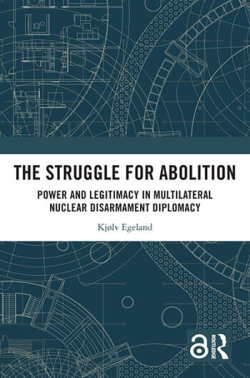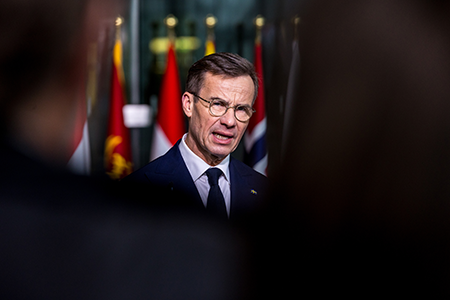The Struggle for Abolition: Power and Legitimacy in Multilateral Nuclear Disarmament Diplomacy
June 2025
A History of Nuclear Haves and Have-Nots

The Struggle for Abolition: Power and Legitimacy
in Multilateral Nuclear Disarmament Diplomacy
By Kjølv Egeland
Routledge
2025
Reviewed by Naomi Egel
Kjølv Egeland’s The Struggle for Abolition: Power and Legitimacy in Multilateral Nuclear Disarmament Diplomacy traces the history of disarmament efforts from the 1968 adoption of the nuclear Nonproliferation Treaty (NPT) to the 2021 entry into force of the Treaty on the Prohibition of Nuclear Weapons (TPNW). In those five decades, Egeland covers the high points of disarmament efforts such as the TPNW and the first UN Special Session on Disarmament, as well as the disappointments and unmet aspirations, from the 1975 NPT Review Conference to the third UN Special Session on Disarmament in 1988.
The word “struggle” in the book’s title aptly characterizes the history of disarmament efforts. The book shows how the dissatisfaction of non-nuclear, mostly neutral, and nonaligned states lacking progress toward disarmament and lacking recognition of their role as sovereign equals led to crises of legitimacy in multilateral disarmament diplomacy. Those crises were at times resolved through institutional reforms and greater commitments by nuclear-weapon states to future nuclear disarmament. In other instances, failures to achieve such reforms and commitments deepened divides between nuclear weapon states and non-nuclear-weapon states.
Egeland contends that the effectiveness of nuclear-weapon states’ efforts to ward off these challenges and reforms depended on when they are taken. They were more likely to succeed when dissatisfied non-nuclear-weapon states still viewed the “nuclear regime complex,” generally understood to be the set of international rules and agreements governing nuclear weapons, as having high legitimacy, and less likely to succeed when such non-nuclear-weapon states viewed the regime as having low legitimacy.
After introducing the concepts of nuclear order and recognition in Chapter 1, subsequent chapters each consider a time period in the development of the nuclear regime complex. Chapter 2 covers the period between 1969 and 1978, Chapter 3 examines 1979 to 2000, and Chapter 4 addresses 2001 to 2021. By taking a chronological approach to understanding disarmament diplomacy, Egeland draws the reader’s attention to underappreciated moments, initiatives, and events that shaped subsequent disarmament efforts.

For example, although the 1996 Model Nuclear Weapons Convention failed to gain traction at the time, it provided a rallying point and a basis upon which nongovernmental organizations and states later pursued the TPNW. The chronological approach to disarmament diplomacy also underscores how long many disarmament efforts have been in the works. For example, Egeland demonstrates how disarmament diplomats and advocates pursued the Comprehensive Test Ban Treaty in the early 1960s, in the context of the development of the Limited Test Ban Treaty, and in the 1990s, and in the intervening years as well.
A central theme of the book is the efforts by non-nuclear-weapon states to achieve recognition as sovereign equals by nuclear-weapon states and to have their priorities and objectives given equal weight to those of nuclear-weapon states. This echoes other scholarship that has emphasized the importance of status-seeking and the desire of smaller states to overcome international hierarchies as a motivator for state action in world politics.1 The Struggle for Abolition underscores the need to take seriously the nonmaterial factors that shape states’ negotiating behaviors in disarmament diplomacy.
Yet this coupling of recognition and disarmament can have the consequence of underappreciating progress toward disarmament that lacked a central role for non-nuclear-weapon states. If disarmament and recognition go hand in hand, steps toward disarmament negotiated by nuclear-weapon states are unlikely to satisfy the recognition demands of certain non-nuclear-weapon states. In describing the reaction of non-nuclear-weapon states to bilateral U.S.-Russian and U.S.-Soviet arms control agreements, the book shows that states at the forefront of disarmament advocacy were disappointed and underwhelmed by the products of bilateral superpower arms control negotiations that lacked participation from non-nuclear-weapon states and that were concluded during periods of disagreement in multilateral disarmament diplomacy.
Conversely, the pairing of disarmament and recognition can lead such states to emphasize the importance of measures that had few material implications but were significant in terms of recognition. For example, in discussing the development of the NPT, Egeland concludes, “If judged as an attempt at tackling the neutral and non-aligned states’ material security dilemma vis-à-vis the nuclear-weapon states and their allies, the NPT’s disarmament language looks next to worthless.” However, “by casting the NPT as a step towards disarmament, Article VI allowed the non-nuclear-weapon states to describe themselves not simply as ‘inferior’ or ‘unequal’, but as ‘equal in waiting.’”
Likewise, in contrasting these states’ positive reaction to the Strategic Arms Limitation Talks (SALT) II, which never entered force as a treaty, and their scorn of SALT I, which did enter into force as a formal treaty, he notes, “What had changed over the course of the second half of the 1970s, of course, was not the contents of SALT but the social environment in which nuclear diplomacy was enacted.” These different reactions to various steps toward disarmament underscore the importance of non-material factors and of recognition, in anticipating whether an action or agreement is likely to satisfy states seeking disarmament.
Although the book does not limit its focus to any specific states, neutral and nonaligned states are often at the center of the struggle for both disarmament and recognition. Sweden and Mexico appear repeatedly as strong disarmament advocates. Yet Sweden’s approach to disarmament and nuclear weapons has changed in recent years. Sweden did not vote in favor of the TPNW in 2017, did not join the TPNW, and has joined NATO since the TPNW entered into force. Although Sweden was a strong Cold War disarmament advocate, it has played a less prominent role in the post-Cold War period, especially after 2010, even before it joined NATO.
Mexico, meanwhile, consistently has been at the forefront of disarmament diplomacy. This raises interesting questions of how stalwart certain states or other actors are in disarmament advocacy: Why do certain actors take leadership roles in disarmament advocacy and why, at some point, do they step back from those roles? If disarmament diplomacy and sovereign recognition go together, why would Sweden reverse its approach, unlike other countries? It does not appear that Sweden’s desire for recognition was fully met or that sufficient progress on disarmament was achieved. More broadly, when is disarmament diplomacy a priority for states and when does it stop being so? Understanding the prioritization of disarmament diplomacy not as a constant attribute of certain states, but as a dynamic shaped by external and internal factors, can help identify when recognition concerns are likely to be especially salient, and for which states.

Lurking through the book is the question of the extent to which disarmament diplomacy and the nuclear regime complex are a distinct negotiating space versus an area of negotiation shaped by external events. At times, the disagreements and the divide between non-nuclear-weapon states seeking disarmament and nuclear-armed states reflects the distinction between haves and have-nots in terms of nuclear weapons. At other times, Egeland and the actors he examines in his book explicitly link crises of legitimacy in the nuclear regime complex to broader divides in world politics, especially those between former colonizers and the formerly colonized, or great powers and the rest. The extent to which disarmament diplomacy is insulated from external events matters because it points to alternatively narrower or broader paths through which legitimacy can be undermined and through which recognition can be achieved.
What does the struggle for nuclear abolition look like today? As nuclear-weapon states appear uninterested in arms control limits or reductions, nuclear and non-nuclear multilateral institutions are under strain, and the NPT continues to be mired in perpetual crisis, prospects for nuclear disarmament appear dim. As a result, the nuclear regime complex appears to have very low levels of legitimacy for many non-nuclear-weapon states. At the same time, the United States and Russia appear less concerned with multilateralism and disarmament diplomacy than perhaps ever, and are reluctant to recognize non-nuclear-weapon states as equals. Domestic actors in countries such as Poland and South Korea are increasingly discussing the possibility of developing their own nuclear weapons.
Yet as Egeland shows, earlier disarmament efforts can lay the groundwork for later achievements, even if they do not succeed at first. Moreover, the nuclear regime complex has contributed to important norms, including taboos against nuclear testing and nuclear use, which have endured. Nonetheless, in a context in which the dominant nuclear-weapon states appear less influenced by international norms and less responsive to pressure from non-nuclear-weapon states, the nuclear regime complex faces serious challenges to sustain past successes, let alone make further progress.
Extensively researched, with rich archival evidence and interviews with participants in disarmament negotiations, The Struggle for Abolition is an important contribution to understanding why the nuclear regime complex has endured thus far, how it has evolved, and how cycles of legitimacy crises have shaped it. By centering the role of non-nuclear-weapon states, this book provides a valuable addition to work that has been more focused on the role of the United States in developing and sustaining the multilateral nonproliferation regime.
ENDNOTES
1. For example, Benjamin de Carvalho and Iver Neumann, eds., Small State Status Seeking: Norway’s Quest for International Standing. (London: Taylor & Francis, 2014); Vincent Pouliot, International Pecking Orders: The Politics and Practice of Multilateral Diplomacy (Cambridge: Cambridge University Press, 2016); Naomi Egel and Steven Ward, “Hierarchy, revisionism, and subordinate actors: The TPNW and the subversion of the nuclear order,” European Journal of International Relations Vol. 28, No. 4 (2022): 751-776; and Rohan Mukherjee, Ascending Order: Rising Powers and the Politics of Status in International Institutions (Cambridge: Cambridge University Press, 2022).
Naomi Egel is an assistant professor in the Department of International Affairs and a faculty fellow at the Center for International Trade and Security at the University of Georgia.
